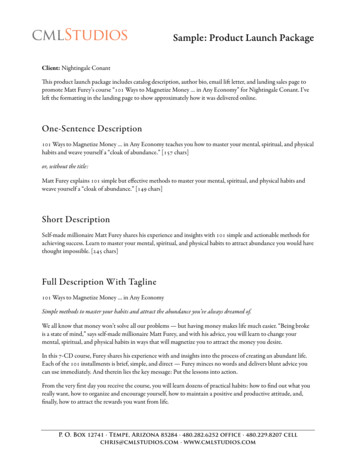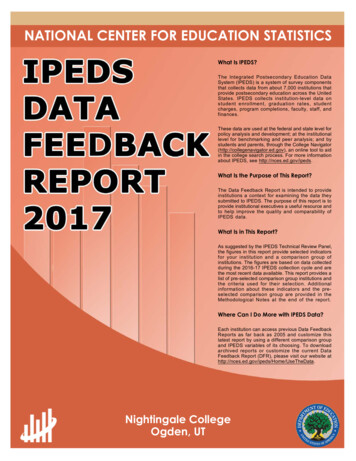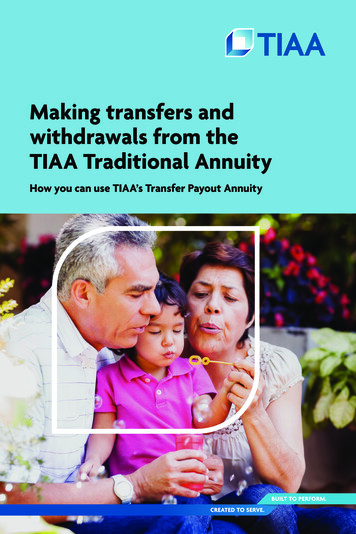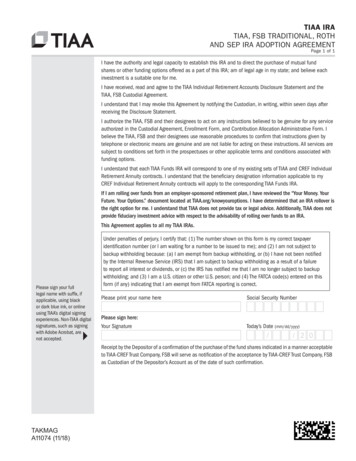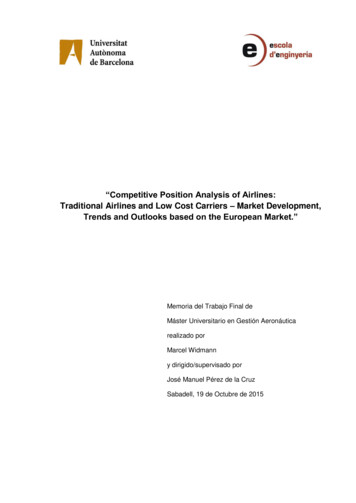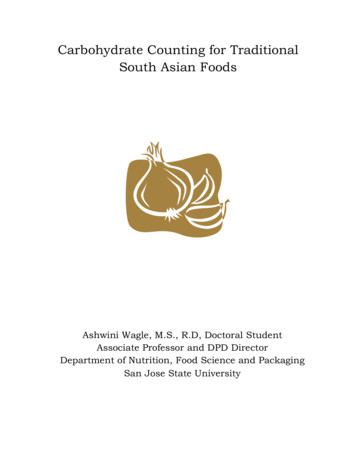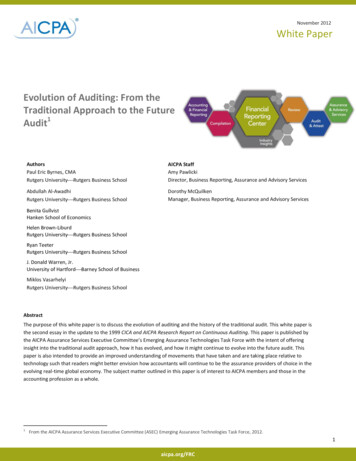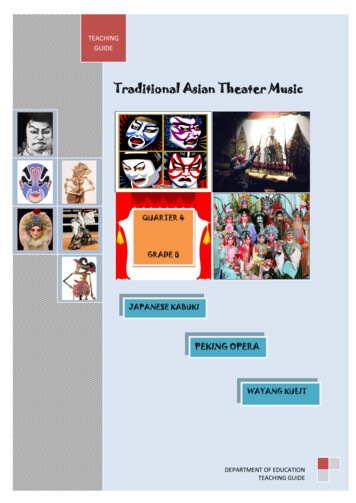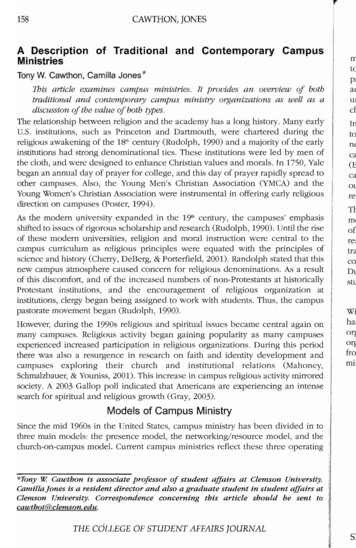
Transcription
r'158CAWTHON, JONESA Description of Traditional and Contemporary CampusMinistriesTony W. Cawthon, Camilla Jones *This article examines campus ministries. It p rovides an overview of bothtraditional and contempo rary camp us ministry organizations as well as adiscussion of the value of both typ es.The relation ship between religion and the ac ademy has a long history. Many earlyU.S. institutions, such as Prin ceton and Dartmouth, were ch artered during thereligiou s awakening of the 18'1. century (Rudo lp h , 1990) an d a ma jority of the earlyinstitutions had strong denomination al ties. These instituti ons we re led by men ofthe cloth, and were de signed to enhance Christian valu es and morals. In 1750, Yalebegan an annua l day of prayer for co llege, and this d ay of prayer rapidly sprea d toother campuses. Also, the Young Men 's Christian Association (YMCA) and theYoung Wom en 's Christian Association we re instrumental in offering early religiousdirection on camp uses (Pos te r, 1994) .As the modem university expanded in the 19th century, the camp use s' emphasisshifted to issues of rigorous scholarship an d research (Rudolph, 1990) . Until the riseof these modern uni versities, religion and moral instruction were ce ntral to thecampus curriculum as religious principl es were equated with the principles ofscience and histor y (Cherry, DeBerg, & Porterfield , 200l). Ran dolph stated that thisnew campus atmos p he re caused co ncern for religious den om inations. As a resultof this discomfort , and of the in creased numbers of non-Protestant s at historicallyProtestant institution s, and the encourageme nt of religious o rganizatio n atinstitutions, clergy began being assigned to work w ith stude n ts. Thus, the campuspastorate movement began (Rudo lph, 1990) .However, during th e 1990s religious an d spir itua l issues becam e ce ntral aga in onmany campuses. Religi ou s activity beg an ga ining popularity as man y campusesexperience d increased participation in religiou s organizations . During this periodthere was also a resurgence in research on faith and identity devel opment andcamp uses ex p loring th eir church a nd institutional rel at ion s (Mahoney,Schmalzb auer, & Youniss, 200 l). This increase in campus religiou s activity mirroredsocie ty. A 2003 Gallop p oll indicated that Amer ican s are experiencin g an intensesearch for spiritual and religious growth (Gray, 2003).ITtcp:a UlclTnton(ca(EcaOlrertm.ofre :tracoDlsttWihaof!or fromi:Models of Campus MinistrySince the mid 1960s in the United State s, campus ministry h as been divi de d in tothree main models: the presence model, the n etworking/resource model , and thechurch-on-campus mo de l. Cu rre nt campus min istries reflect these three operating*Tony W Cawthon is associate professor of student affairs at Clemson Un iversity.Ca m illa jones is a resident director and also a graduate student in student affairs atClemson University. Co rresp ond ence concerning this article should be sent to ,cawthot@clemson.edu.'THE Cc5LLEGE OF STUDENT AFFAIRS JOURNALS:
A Description of Traditional and Contemporary Campus Ministries159models; however many reflect the church-on-campus model. From the mid 1960sto the mid 1970s (the presence model), campus ministry was on campus as apassive voice, interpreting and responding to the changes and development of theacademic community. During this time period, the campus ministries operatedunder the assumption that the students and faculty had an understanding of thechurch's mission (Brittain, 1988).In the late 1970s, local churches saw that the campus ministries could be of serviceto them, by encouraging the students to attend services. During this time of thenetworking/resource model, campus ministries led students to activities. Thecampus ministry "would not so much do ministry as enable ministry to occur"(Brittain, 1988, p. 674). Also, in the same time as the networking/resource model,campus ministries began to shift from the spiritual and ministerial nature to anoutward view towards world injustice, crime, and poverty (the shift to socialresponsibility; Winings, 1999).The late 1980s introduced the last model of campus ministry, the church-on-campusmodel, which provided persons on campus the worship and study of the traditionof a local church, yet outside the local church setting. Campus ministers began torealize during this time that although many students were familiar with thetraditions of the church and religion, for many other students and faculty theconcepts taught and discussed through the ministry were new (Brittain, 1988).During this time period campus ministries began to offer an increased number ofstudy groups and worship services within the campus ministry setting.National OrganizationsWith the increased interest in campus ministry organizations on campus, the needhas grown for the national support of campus ministers. While many contemporaryorganizations have national headquarters, the campus ministry nationalorganizations allow ministers and lay people a chance to interact, share, and learnfrom each other. The following list presents national organizations for campusministers as they describe themselves. National Campus Ministry Association (NCMA): Founded in 1964, NCMAfocuses on bringing an ecumenical focus to the campus ministry settingthrough support of Christian ministry in and around the campuscommunity. (National Campus Ministry Association, n.d.) The Higher Education Ministries Arena (HEMA): HEMA is based out of theCouncil for Higher Education Ministries (CHE Ministries, Inc.), and isstructured to aid in goal achievement through ecumenical work of severalProtestant denominations. (Higher Education Ministries Arena, n.d.) The National Association of College and University Chaplains (NACVC):Founded in 1948, this multi-faith organization whose members includechaplains, Hillel directors, campus ministers, and directors of religious lifegives support to all those concerned with religious life on the collegecampus. (National Association of College and University Chaplains, n.d.)SPRING 2004 - VOLUME 23, NUMBER 2SPECIAL ISSUE ON FAITH, SPIRITUALITY, AND RELIGION ON CAMPUS
CAWTH ON, JONES160 Associa tion of Colleg e and Universi ty Religio us Affairs (ACURA): Begu n in1959, th e Association of College an d University Religious Affairs is anation al association of de an s of religious life, chaplains, and otherswo rking in religio us affairs. It is an int erfaith group of individuals w hosechief conce rn is the role of religion in high er edu catio n. (Associatio n ofCollege and University Religiou s Affairs, n .d .) The Ivy Jungl e Network: Fou nded in 1993 , the Ivy Ju ng le Netw orkencompasses over 10,000 me mbers (c haplains , ca mpus ministers, para church staff, stu de nts and fac ulty) th at foc uses o n ministry to all ,colleg ians-com muters, re sid ential , traditional, or n on-traditi on al stu dents .(Ivy Jungle , n. d.) The Assoc iation for Relig ion and Intellectu al Life (ARIL): ARIL prov idesrefe rences for campus ministe rs to use for ed uca tio n including an o nlinejourna l, Crosscurrents. (Associatio n for Religion and Intelle ctual Life , n.d .)The Council for Ecu menical Student Christian Ministry (CESCM): CESCM isan ecumenical group partnered together to celebrate the diversity betweenthe m and the co mmon bon d they sha re in ministry. (Co u nc il forEcume nical Student Christian Ministry, n.d.)noairr((mp:\ '1;C1pIWpIStMccThe Associa tio n for Christians in Student Development (ACSD): ACSD wasdesigne d to support profession als in high er educatio n as th ey me rge theirfaith with th eir commitment to the enhan cement of co llege stu de ntde velopme nt. (Associatio n for Christians in Student Developmen t, n.d.)(IvThese o rganizatio ns and associations for ca mpus mini ste rs, cha plains , or othersinvolved in min istry to co llege student' allow for th e shared ideas a nd support thatare necessities for growth and devel op men t.RecnCc Traditional and Contemporary Campus Ministry OrganizationsTo better serve th e needs of stu de nts, student affai rs professio na ls need tounderstand the distin ction be tween trad itio nal and co nte mporary campus ministries.The traditiona l ca mpus m inistries are th ose ministries direc tly relate d to onedenomination suc h as Baptist Student Union, Pre sb yterian Stud ent Association,Catholic Student Association and Newman Club s, Hillel : The Foundation fo r Je wishCampus Life, Reforme d Universi ty Fellowship, Canterbury (Episcopa l), UnitarianUniversalist Fellowship, or United Methodist Wesley Foundation. The contemporaryorganiza tions are th ose th at are not publicly or well-known to be affiliate d w ith aparticul ar denomin ation . Exa mples of the co ntempora ry o rga nizations areFellowship of Ch ristia n Ath letes, Ca mpus Cru sade for Christ, Inte rVarsityFellow ship, and The Navigator s,The next section of thi s article p rovides an overview of ea ch of th ese campus !'ministries organizations. Specifically, the history, mission and goals, o rganizationalst ruct ure, and fu ture commitme nt o f th e se ca m p us organiza tions to hi gh er :education and religious develo pme nt a re offere d , b ase d o n th e way th eseorga nizations describe themselves. The campus ministries pres ented are by noTH E COLLEGE OF STUDENT AFFAIRS JOURNALsttD(StiMistuansuein ,re§(p(AID\V hwe .nrgcanThlth ew il.51
A Description of Traditional and Contemporary Campus Ministries161means exhaustive and are presented only as a sample of campus ministryorganizations.Traditional Campus Ministry OrganizationsBaptist Student UnionWhether called Baptist Campus Ministries, Baptist Student Ministries, or BaptistStudent Unions (BSU), these Southern Baptist Convention-affiliated organizationsare one of the largest Christian campus ministries in the United States. Located onmore than 1,050 campuses, these organizations serve over 100,000 students(Carson-Newman College Campus Ministries, n.d ). Funded by Baptists, BSUs arenot operated as churches, and they are typically not affiliated with anyoneparticular Baptist congregation but serve as links to area churches.With the establishment of the Baptist Young People's Union (BYPU) in 1895, Poster(1994) states that soon the BYPU was in many campuses and served as theprototype of today's BSU. In 1904, a group of students at Baylor University inWaco, Texas, began praying that the Texas Baptists would establish a studentprogram, and in 1914, the state convention approved a motion to create a BaptistStudent Missionary movement. The first meeting of the Baptist Student MissionaryMovement was held in Texas creating momentum, and in 1919 the Texas BYPUconvention recommended a person who would work full-time with Baptiststudents (Poster, 1994). Soon thereafter, the Texas Convention created a StudentDepartment, and in 1920 the first Baptist Student Union Convention was held(May, 1963).Recognizing the needs of students, in 1920 the Southern Baptist Conventioncreated an Inter-Board committee to coordinated student activities of threeConvention agencies, and in 1921 the Convention voted to create the BaptistStudent Association. Frank Leavell was chosen to direct the Baptist CampusMinistries. He structured this organization around Baptist principles; challengedstudents to make a difference where they were; saw the local church as the link;and offered publications, programs, and resources (Poster, 1994). Leavell hadsuccess organizing regional conferences to enhance student leadership andinvolvement, and soon other state conferences followed. It was at one of the 1924regional conferences that the name Southern Baptist Student Union was adopted(Poster, 1994).Alford (l997a) states the largest growth in campus ministries was in the 1970swhen the number of campus ministries significantly increased. The 1980 and 1990swere focused on examining the purpose and structure of campus ministries. BSUorganizations have realized that despite more than 600,000 Baptist students oncampuses, two-thirds of those students still do not participate in BSU activities.Thus, Baptist Campus Ministries have implemented new strategies for seekingthese students. These strategies include programs such as CrossSeekers, awillingness to cooperate with other campus ministry organizations, and theSPRING 2004 VOLUME 23/ NUMBER 2SPECIAL ISSUE ON FAITH, SPIRITUALITY, AND RELIGION ON CAMPUS
162CAWTHON, JONE Sde velopment of a rel ationsh ip w ith LifeWays Church Resources Division, Na tio nalCollegiate Ministries Department.Presbyterian Student Asso ciat ionsMany campuses have a Pres byte rian Stude nt Asso ciati on th at is affiliated with thePresbyterian Church (U.S.A). Th e Presb yterian Church ( U.S.A.) organi zed th eir firststude nt organization at th e Unive rsity of Michiga n in 1905 (Pos te r, 1994) . This initialinvolvement continu es today, as th e churc h h as a relationship with over 70 sc hoolsand instituti ons of high er educ ation (Pres byte rian Church USA, n.d.).The Presbyterian Chu rch (U.S.A.) is stro ng ly co mmitted to supporting students inhigher educa tion . To en ha nce th e relationship of the Presbyterian Church (U.S.A.)with these institutions, ca mp us o rganizations work in con junction with the church 'sHigher Educatio n Ministries and Students' Ministries unit. To achiev e thi s mission,they have established the Presb yterian Colleg iate Co n nec tio n (Presbyterian ChurchUSA, n.d .).The Presbyterian Collegiate Connectio n (PCC) is desi gned to b e an easy way fo rco llege students an d those who work in stu de nt ministries to connect and sharereso urces . Promoting biblical an d sp iritua l understanding from th e viewpoint of th eProtestant Reformed tradition, PCC attempts to help stu de nts understand thedistinctive ne ss of being Presbyteri an. PCC, under th e guidanc e of a Pre sbyterianStude nt Strategy Team , is a student grou p tha t allows students to parti cip ate in thegeneral assembly of the church. The PCC strives to connect g radu ating high sch oolseniors with the ca mpus ministri es at th e schools th ey will b e atte nd ing(Presbyterian Churc h USA, n .d .) .Catholic Campus Ministry and Newman ClubsRudolph (1990) sta tes th at the University of Wiscons in w as ho me to the first theundergraduate Catholic stu dent organi zation in 1880. Starte d as a literary club tohelp others develop an understanding of Catholicis m, th is organization was apred ecessor of what is known today as th e Newman Clu b. The Newman Club ,started at the Unive rsity of Pennsylvania, and Catholic stu de nt movements definethe "official presence of the Catholic Church o n ca m pus" (Worcester Polyte chnicInstitut e , n.d. , paragraph 4, line 3) through more than 1,200 organized Catho licCampus ministr ies serving the o ne million Catho lic co llege students. In addition toNewman Cen ters, th ese orga nizatio ns are known by a variety of names includingUnive rsity Parish es, Campus Ministry Departments, Campus Ministry Offices, andCatholic Stude nt Associations (Worcester Polyte chnic Institute , n .d.) . Wh at ever thenames used, the founda tio n of these organizations is a prog ram of religious, social,and intellectual development (Iones & Matani c, 1996).Wh ile th e re are 23 5 Ca tho lic Institutions , a g reater p rop ortion of Catholicsstudents atte nd secula r co lleges (Line ha n, 1995). Jones and Matanic (1966) statedthat in recent years numerous stu d ies have repo rte d that Cat holic stu de nts are ingreate r need o f th e services p ro vided by th e Ne w m an Ce nters in their desire tolearn more about the ir Catholic faith; however, financial su p port of these centers iswaning . As late as 1989, th e re were over 2,000 Catholic campus mi n istr ie s in theTHE COLLEGE OF STUDENT AFFAIRS JOURNALrI fscf tcSll'Ca1sta L If.a foHreInst.WIB' ,puRefaepfln.cREHemLautSO L1'hlserLmuncUn]tenmis5J
A Description of Traditional and Contemporary Campus Ministries163United States, but by 1996, this number had decreased to 1,800, as many campusesare experiencing financial cuts of up to 50% in their campus ministries (Jones &Matanic, 1996).Hillel: The Foundation of Jewish Campus LifeHillel, the largest Jewish campus organization, is designed to allow Jewishstudents to investigate and rejoice in their Jewish history and identity, iscommitted to all types of Judaism, and has open membership to any student.Hillel campus organizations exist on over 500 campuses with their mission beingto "maximize the number of Jews doing Jewish with other Jews" (Hillel, n.d.,section two, paragraph two).Hillel was founded by Rabbi Benjamin Frankel in 1923 at the University of Illinois,Champaign-Urbana, and became an international organization in 1994. Hillelattempts to connect with uninvolved Jewish students, and to encourage Jewishstudents to take responsibility for their identity and engage in meaningful Jewishactivities (Hillel, n.d.).Local campus chapters operate interdependently under the auspices of anInternational Board of Directors, regional offices, and international centers thatassist with operations. Additionally, Hillel is supported by individual benefactors,foundations, Jewish federations, and international organizations. Major projects ofHillel include operation of the Steinhardt Jewish Campus Service Corps (hiringrecent college graduates to serve on over a 100 campuses to assist students), SorefInitiative for Emerging Campuses (support for campuses without full-time Hillelstaff), Hillel's Charles Schusterman International Student Leaders Assembly (anworld-wide assembly of student leaders), and the Charlotte B. and Jack J. SpiterB'nai B'rith Hillel Forum on Public Policy (a three-day seminar for students onpublic policy and social action; Hillel, n.d.).Recently having completed a 210 million campaign, Hillel has also built 19 newfacilities on college campuses, with 12 more being planned. The staff of 1,000professionals is committed to the renaissance of Jewish life on campuses (Hillel,n.d.),Reformed University FellowshipHeadquartered in Georgia, Reformed University Fellowship (RUF) serves as aministry of the Presbyterian Church in America (PCA). Built on PCA's tenets ofauthority, necessity, and task, RUF operates on 75 campuses (primarily in thesoutheastern portion of the country) and offers a total ministry to college students.The basic premise of RUF is to reach students for Christ and to equip students toserve Christ. Founded in 1971 at the University of Southern Mississippi by MarkLowery, campus chapters are referred to as RUF, whereas nationally they operateunder the Reformed University Ministries (Maxwell, n.d.).Unique to RUF is its philosophy of ministry and commitments. Building on thetenets of PCA, RUF has four goals: (a) growth in grace, (b) evangelism andmissions, (c) fellowship and service, and (d) a biblical world and life viewSPRING 2004 VOLUME 23, NUMBER 2SPECIAL ISSUE ON FAITH, SPIRITUALITY, AND RELIGION ON CAMPUS
164CAWTHON, JONESr(Reformed Unive rsity Fellowship , n .d.). RUF stresses an act ive p rayer life andstudying of the Bible and sha ring and w itness ing the message of Go d to others inthe institution. RUF e mphas izes the ex pectation of serving as a Chris tian role modelon the camp us and the realization th at Ch ristian ity is a w ay of viewing all of life .RUF emp hases are commitme nts to the visible church, in-de pth Bible stu dy , thestudent's vocation , an emphasis on being rather than doin g, an d critical thinking.These ministries are not to tak e the place of the church, but to se rve as th e churchgoing to camp us. RUF also ma intains that college stude nts a re interested indeveloping a relationship with God, and this relationship ca n be fostered by indepth Bible study (Reforme d University Fellowship, n.d .).Episcopal Society for Ministry in Higher EducationThe Episcopa l Society for Ministry
College and University Religious Affairs, n.d.) The Ivy Jungle Network: Founded in 1993, the Ivy Jungle Network encompasses over 10,000 members (c haplains, ca mpus ministers, para church staf
